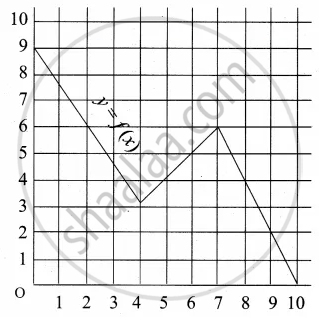Advertisements
Advertisements
प्रश्न
Write the following expression as sum or difference of logarithm
In `(("a"^3 ("a" - 2)^2)/sqrt("b"^2 + 5))`
उत्तर
In `(("a"^3 ("a" - 2)^2)/sqrt("b"^2 + 5))`
= In (a3 (a – 2)2) – In `sqrt("b"^2 + 5)` ...`[log "m"/"n" = log "m" - log "n"]`
= In a3 + In (a – 2)2 – In `("b"^2 + 5)^(1/2)` ...[log mn = log m + log n]
= 3 ln a + 2 ln (a – 2) – `1/2` In (b2 + 5) ...[log mn = nlog m]
APPEARS IN
संबंधित प्रश्न
If f(x) = x2, find \[\frac{f\left( 1 . 1 \right) - f\left( 1 \right)}{\left( 1 . 1 \right) - 1}\]
If \[f\left( x \right) = \frac{2x}{1 + x^2}\] , show that f(tan θ) = sin 2θ.
If f, g and h are real functions defined by
Let f and g be two functions given by
f = {(2, 4), (5, 6), (8, −1), (10, −3)} and g = {(2, 5), (7, 1), (8, 4), (10, 13), (11, −5)}.
Find the domain of f + g
If \[f\left( x \right) = \frac{2^x + 2^{- x}}{2}\] , then f(x + y) f(x − y) is equal to
The function f : R → R is defined by f(x) = cos2 x + sin4 x. Then, f(R) =
Let \[f\left( x \right) = \sqrt{x^2 + 1}\ ] . Then, which of the following is correct?
A function f is defined as follows: f(x) = 4x + 5, for −4 ≤ x < 0. Find the values of f(−1), f(−2), f(0), if they exist.
Which sets of ordered pairs represent functions from A = {1, 2, 3, 4} to B = {−1, 0, 1, 2, 3}? Justify.
{(1, 3), (4, 1), (2, 2)}
Check if the relation given by the equation represents y as function of x:
2x + 3y = 12
Find the domain and range of the following function.
f(x) = `root(3)(x + 1)`
Check the injectivity and surjectivity of the following function.
f : N → N given by f(x) = x3
lf f(x) = 3(4x+1), find f(– 3)
Express the following exponential equation in logarithmic form
`9^(3/2)` = 27
Express the following exponential equation in logarithmic form
e2 = 7.3890
Express the following exponential equation in logarithmic form
e–x = 6
Express the following logarithmic equation in exponential form
log10 (0.001) = −3
Express the following logarithmic equation in exponential form
In `1/2` = – 0.693
Solve for x.
log2 + log(x + 3) – log(3x – 5) = log3
Answer the following:
A function f is defined as : f(x) = 5 – x for 0 ≤ x ≤ 4. Find the value of x such that f(x) = 5
Answer the following:
Simplify `log_10 28/45 - log_10 35/324 + log_10 325/432 - log_10 13/15`
Answer the following:
If b2 = ac. prove that, log a + log c = 2 log b
Answer the following:
Find the range of the following function.
f(x) = `1/(1 + sqrt(x))`
Answer the following:
Find the range of the following function.
f(x) = 1 + 2x + 4x
Given the function f: x → x2 – 5x + 6, evaluate f(2a)
A graph representing the function f(x) is given in it is clear that f(9) = 2

What is the image of 6 under f?
The data in the adjacent table depicts the length of a person's forehand and their corresponding height. Based on this data, a student finds a relationship between the height (y) and the forehand length (x) as y = ax + b, where a, b are constant.
| Length ‘x’ of forehand (in cm) |
Height 'y' (in inches) |
| 35 | 56 |
| 45 | 65 |
| 50 | 69.5 |
| 55 | 74 |
Find a and b
Domain of function f(x) = cos–1 6x is ______.
Find the range of the following functions given by `|x - 4|/(x - 4)`
Find the domain of the following functions given by f(x) = `1/sqrt(x + |x|)`
Find the range of the following functions given by f(x) = 1 – |x – 2|
Range of f(x) = `1/(1 - 2 cosx)` is ______.
The domain of the function f defined by f(x) = `sqrt(4 - x) + 1/sqrt(x^2 - 1)` is equal to ______.
Let f(x) and g(x) be two real polynomials of degree 2 and 1 respectively. If f(g(x)) = 8x2 – 2x, and g(f(x)) = 4x2 + 6x + 1, then the value of f(2) + g(2) is ______.
Which of the following functions is NOT one-one?
The range of the function f(x) = x2 + 2x+ 2 is ______.
The period of the function
f(x) = `(sin 8x cos x - sin 6x cos 3x)/(cos 2x cos x - sin 3x sin 4x)` is ______.
